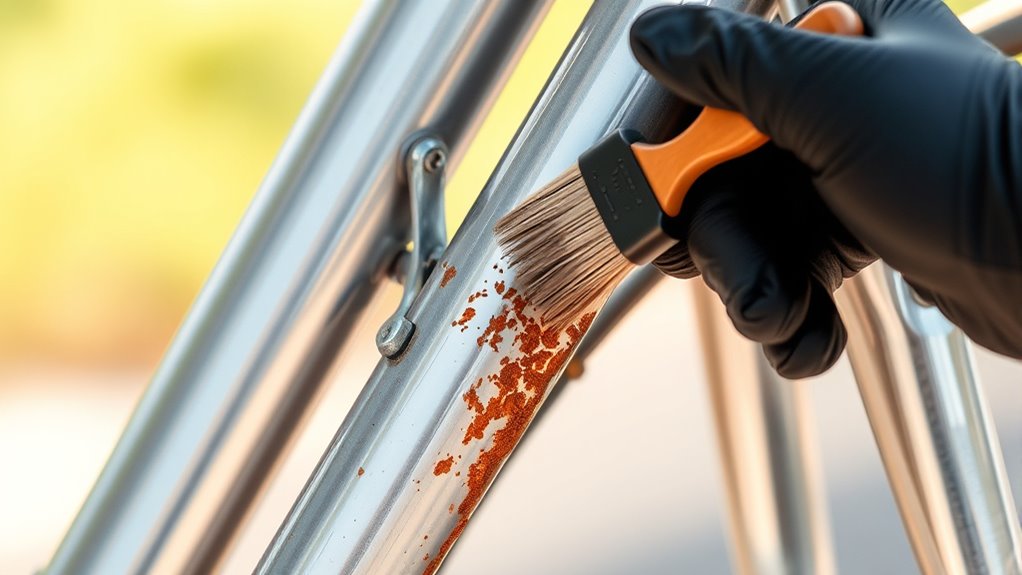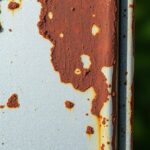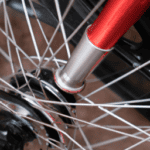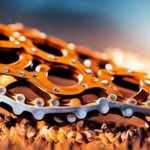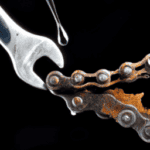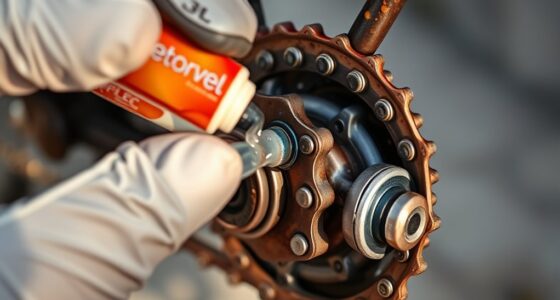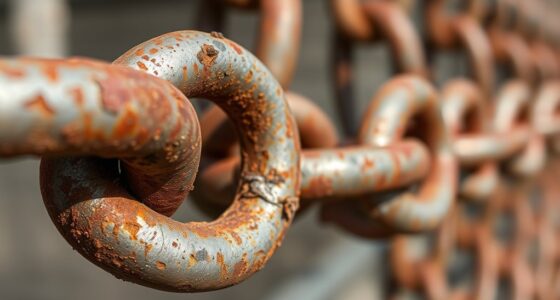To remove rust from your bike frame, start by inspecting the damaged areas and cleaning the surface with soap and water to remove dirt. For light rust, apply a baking soda paste and scrub gently, or use vinegar or cola to loosen stubborn spots. For tougher rust, consider chemical rust removers following instructions carefully. After treatment, dry the bike thoroughly and apply a protective coating or paint to prevent future corrosion. Following these steps will help restore your bike’s appearance and durability; learn more for detailed techniques.
Key Takeaways
- Inspect the frame thoroughly to assess rust severity and remove all removable components for complete access.
- Use gentle cleaning methods with soap, water, and soft brushes to remove dirt and loose rust.
- Apply rust removal techniques such as baking soda paste, vinegar, or chemical rust removers with proper safety precautions.
- Rinse thoroughly, dry the frame in sunlight, and apply protective coatings like wax or paint to prevent future rust.
- Maintain the bike regularly by cleaning, drying, and reapplying protective lubricants or coatings to prevent rust recurrence.
Assessing the Rust Damage and Preparing the Bike

Before you begin removing rust from your bike frame, it’s essential to assess the damage carefully. Start by inspecting the entire frame for signs of rust, like discoloration, pitting, and flaking paint. Document the condition of decals and paintwork with photos to preserve the bike’s original look. Determine if the rust is just surface-level or has penetrated deeper, which could impact the bike’s structural integrity. Remove all removable components—wheels, pedals, accessories—so you can access the entire frame for thorough rust removal. Also, check for cracks or weak spots that may need professional repair before proceeding. Proper assessment helps you choose the right rust removal techniques and ensures your bike remains safe and functional after cleaning. Additionally, understanding the different rust removal methods can help you select the most effective approach for your situation. Conducting a thorough assessment can also prevent potential safety issues later on, especially if rust has compromised the frame’s structural integrity. To further protect your bike after rust removal, consider applying a protective coating to prevent future corrosion.
Cleaning the Frame and Removing Surface Dirt

Start by rinsing your bike frame with gentle water or a damp cloth to lift off loose dirt. Use a soft sponge or brush with mild soap or a bike-specific cleaner to scrub away stubborn grime, then rinse thoroughly and dry completely. If you need to, carefully disassemble components to access hard-to-reach areas and let the bike sun-dry to prevent moisture buildup. To prevent surface rust from forming, consider applying a protective coating or rust inhibitor after cleaning. Regular maintenance and proper storage can also help keep rust at bay and extend the life of your bike. Additionally, maintaining proper color accuracy in your cleaning process ensures that protective coatings are evenly applied and effective.
Gentle Washing Techniques
To effectively clean your bike frame and remove surface dirt, begin by spraying a gentle stream of water or wiping it with a damp cloth to loosen loose debris. This gentle washing helps prevent scratching and prepares the surface for rust removal. Use a soft sponge or microfiber cloth with mild dish soap to clean the frame carefully, avoiding abrasive scrubbers or steel wool that can damage the finish. Focus on these key steps:
- Rinse thoroughly with clean water to eliminate soap residue.
- Use a gentle touch to prevent scratching paint or finish.
- Dry completely with a soft towel or let it air dry in sunlight to avoid moisture buildup.
- Incorporating regular maintenance into your routine can significantly extend the lifespan of your bike frame and prevent rust formation. Additionally, choosing rust-resistant paints or coatings can provide an extra layer of protection against corrosion. Understanding advanced cleaning techniques can further enhance your bike’s longevity and appearance.
- Applying a protective coating after cleaning can help shield your bike from future rust and environmental damage. Proper maintenance practices are essential to avoid issues like rust formation and ensure your bike remains in optimal condition.
Drying and Sun Exposure
Once you’ve finished cleaning your bike frame, it’s important to allow it to drain thoroughly and then dry it in direct sunlight for at least 30 minutes. This drying process helps evaporate any residual water on the surface, reducing the chance of new rust forming. Use a soft cloth or sponge to wipe off remaining dirt or water before placing the bike in sunlight, ensuring all surfaces are dry. Recognizing signs of rust is crucial to prevent further corrosion, so thorough drying is essential. Sun exposure accelerates drying and minimizes moisture buildup, which is vital for preventing rust. Avoid leaving your bike in shaded or humid areas after cleaning, as trapped moisture can promote corrosion. For best results, always dry and expose your bike to sunlight immediately after rain or mud, safeguarding your frame against rust and prolonging its lifespan. Proper post-cleaning care not only extends the life of your bike but also keeps it looking new and functioning smoothly. Additionally, understanding AI vulnerabilities in safety systems can help develop better protective measures for your equipment. Implementing automated insights can further enhance your maintenance routine, ensuring early detection of potential issues before they become serious. Regular inspections of your bike frame for early rust formation can save time and repair costs in the long run.
Disassembling Components Carefully
Before disassembling your bike components, take a few moments to photograph each part and bolt. This helps guarantee correct reassembly and prevents mistakes. When disassembling components carefully, remember to:
- Remove all accessories, such as reflectors and lights, to avoid damage.
- Use appropriate tools like Allen wrenches or screwdrivers to prevent stripping threads.
- Keep track of bolts and small parts to avoid losing them.
- Pay attention to surface rust and how it affects the integrity of your bike’s parts, as it can indicate deeper issues that need addressing. Additionally, consider inspecting the structural integrity of your frame if rust is present, since corrosion can sometimes compromise safety. Regularly inspecting for corrosion can help catch issues early and prolong the lifespan of your bike. Implementing proper preventive maintenance can minimize future rust development and protect your investment. Gently wash each part with soapy water and a soft brush or sponge to remove surface dirt and grime. Take your time to disassemble carefully, especially when dealing with rust from a bike, to avoid damaging delicate parts. Dry everything thoroughly afterward to prevent moisture from causing further rust or corrosion.
Applying Baking Soda Paste for Rust Removal
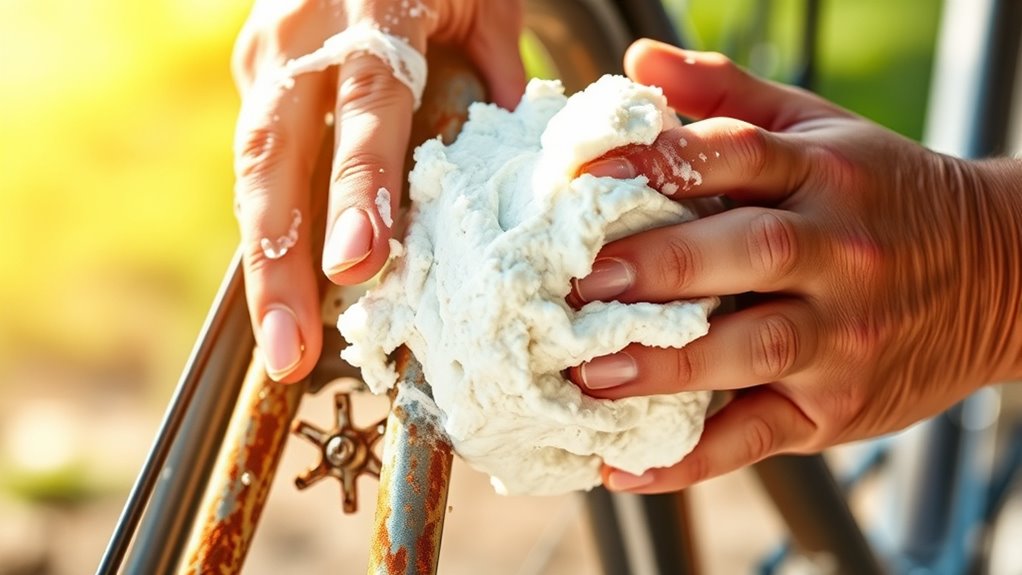
Mix equal parts baking soda and water to form a thick paste, then apply it generously to the rusted areas using a sponge or brush. Press firmly to make certain the paste contacts the rust, and let it sit for 10-15 minutes to loosen the particles. Afterward, scrub off the residue with a damp sponge or soft brush, repeating if necessary for stubborn spots.
Preparing the Baking Paste
To prepare the baking soda paste for rust removal, start by combining equal parts baking soda and water in a bowl. Mix until you get a thick, spreadable paste suitable for tackling rust on your bike frame. If the rust is severe, add a bit more baking soda to increase the paste’s effectiveness while maintaining a manageable consistency. Using a sponge, brush, or spatula, apply the paste directly onto rusted spots, pressing firmly to ensure good contact. Keep the paste thick enough to stay in place. The key to successful rust removal is proper preparation, so make sure the paste covers all rusted areas thoroughly. This simple mix makes the baking soda highly effective at loosening rust and restoring your bike’s appearance. Additionally, understanding common financial terms can help you budget for maintenance or repairs effectively.
Applying and Scrubbing Effectively
Once you’ve prepared your baking soda paste, apply it directly onto the rusted areas using a sponge, brush, or spatula. Be sure to press firmly so the paste makes good contact with the rust. Applying the paste evenly ensures it penetrates the rust and loosens it effectively. After applying, let the paste sit for 10-15 minutes to give it time to break down the rust. When scrubbing, use a soft brush or sponge to gently scrub away the paste along with the loosened rust. Don’t rush—repeating the applying and scrubbing process might be necessary for stubborn spots. Once you’ve removed the rust, rinse the area thoroughly and dry it completely to prevent new rust from forming. Proper applying and scrubbing are key to a clean, rust-free bike frame.
Using Vinegar or Cola to Loosen Rust
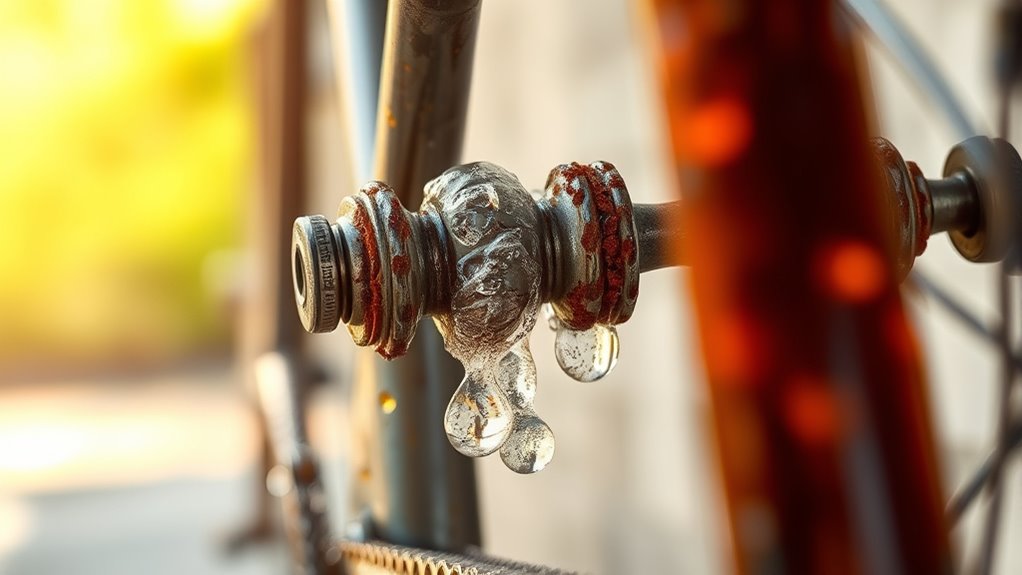
Applying vinegar or cola directly to rusted areas is an effective way to loosen corrosion on your bike frame. Spray the rust remover onto the affected spots, ensuring full coverage. Let it sit for a few minutes to break down the rust. To enhance the process, use a brush wrapped in tinfoil to scrub the rusted parts firmly, helping to lift stubborn corrosion. After scrubbing, rinse the area thoroughly with water to remove any acidity and prevent further rusting. For tougher spots, combining vinegar or cola with baking soda can boost rust removal. Remember to dry the bike completely afterward to avoid residual acidity that could cause additional rust. Using vinegar or cola is a simple, inexpensive method to loosen rust and prepare your bike frame for further cleaning.
Employing Chemical Rust Removers for Stubborn Spots
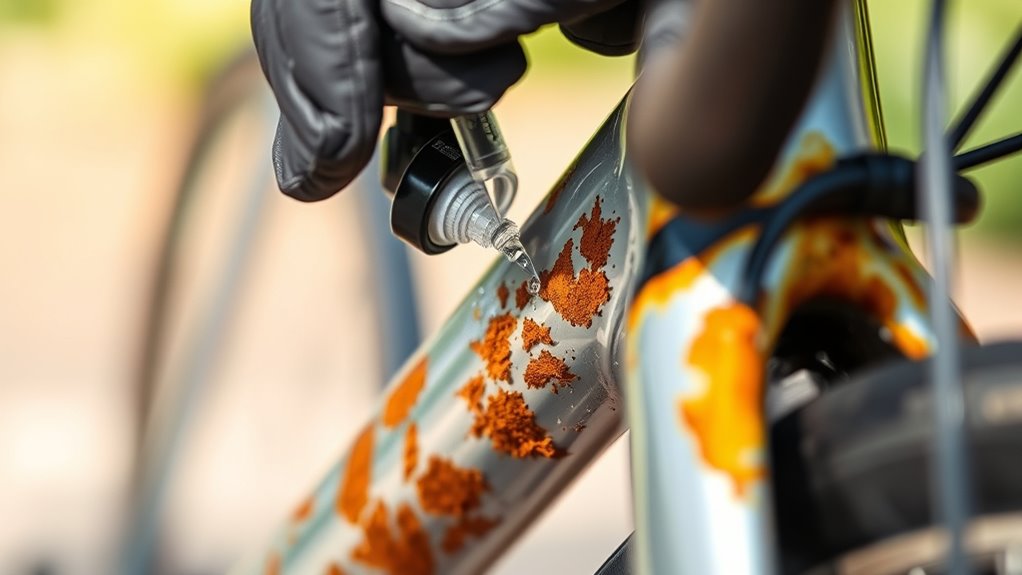
When dealing with stubborn rust spots on your bike frame, chemical rust removers can be highly effective. These rust removers contain acids like phosphoric or oxalic acid that dissolve rust and convert it into a removable substance. Before applying, always wear protective gloves and eye protection to prevent irritation. Carefully follow the manufacturer’s instructions, including proper application times and rinsing procedures, to avoid damaging the paint or metal. Chemical rust removers work best on heavy or stubborn rust that mechanical methods can’t remove alone. Once you’ve applied the rust remover, thoroughly wash the area with water to neutralize the chemicals. Finally, consider applying a protective coating afterward to prevent future rust formation and keep your bike frame in great shape.
Protecting the Frame and Finishing Touches

How can you guarantee your bike frame stays protected after removing rust? The key is in proper safeguarding and finishing. First, mask threaded areas before applying rust removal treatments to avoid damage to critical components. Once the rust is gone, choose durable finishing options like powder coating or spray paint to shield the frame from future rust. Applying a clear protective layer, such as wax or oil, seals the surface and inhibits rust formation. To ensure a long-lasting, attractive finish, properly prepare the surface before finishing. Remember to:
- Mask critical areas during treatments
- Select high-quality, protective finishes
- Reapply wax or oil regularly
These steps help maintain your bike’s aesthetic appeal and extend its lifespan through effective protecting and finishing.
Preventing Future Rust Formation and Maintenance Tips

To effectively prevent future rust, you need to keep your bike clean, dry, and well-maintained. Regularly cleaning your bike and drying it thoroughly after exposure to moisture removes dirt and prevents rust from taking hold. Applying a protective layer of wax, oil, or rust-resistant lubricant to the frame and vulnerable parts creates a barrier against moisture and oxygen, slowing corrosion. Store your bike indoors or under a waterproof cover to shield it from rain, humidity, and salty air that accelerate rusting. Promptly repairing scratches and paint chips helps prevent rust from entering exposed metal areas. Conduct routine maintenance, such as checking and reapplying protective coatings, to ensure your bike stays rust-free and extends its lifespan. Consistent care is key to long-term protection.
Frequently Asked Questions
Can You Remove Rust From a Bike Frame?
Yes, you can remove rust from your bike frame. Start by inspecting the rust to determine its severity. For superficial rust, use a wire brush or fine sandpaper to scrub away the corrosion. For more stubborn rust, apply a chemical rust remover or vinegar. After removing rust, consider using a rust converter to prevent future corrosion. Regular maintenance and applying protective coatings will keep your bike looking great and rust-free.
Does WD-40 Remove Rust on Bikes?
Did you know WD-40 was originally designed as a rust preventative? It does help remove rust on bikes by penetrating rusted areas and loosening stuck parts. You spray WD-40 on the rusty spots, wait a few minutes, then scrub with a wire brush or steel wool. Remember to clean the area afterward and apply a protective coating to prevent future rust buildup. It’s a handy, versatile solution for light rust issues.
How Do You Remove Rust From a Frame?
When you want to remove rust from a frame, start by gently scrubbing loose rust with a wire brush or fine-grit sandpaper. Apply a rust converter or soak spots in white vinegar or lemon juice to dissolve rust. For light rust, use crumpled aluminum foil dipped in soapy water. After cleaning, rinse thoroughly and apply a protective coating like wax or rust-resistant primer to prevent future rust.
Does WD-40 Remove Rust?
Think of WD-40 as a magic wand for rust, but it’s more like a gentle spell than an instant fix. It can loosen light surface rust and displace moisture, helping to prevent further corrosion. However, it’s not a heavy-duty rust remover. For stubborn rust, you’ll need to use it with abrasive tools or consider stronger rust removers. WD-40 is great for maintenance, not deep rust removal.
Conclusion
Now that you know how to tackle rust on your bike frame, you’re unstoppable! With these simple steps, you can restore your bike to look brand new—like it just rolled off the assembly line. Regular maintenance and quick action will keep rust at bay, ensuring your ride stays smooth and shiny for miles to come. Don’t let rust win; your bike deserves to shine brighter than the sun!
